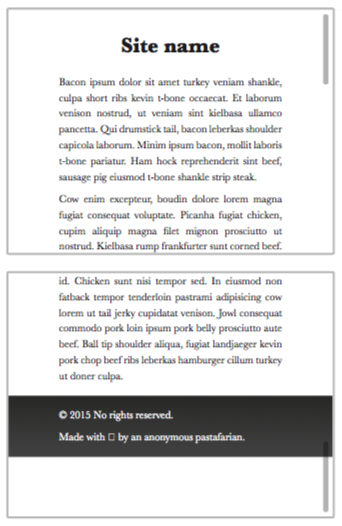Sticky footers设计是最古老和最常见的效果之一,它可以概括如下:
1 如果页面内容不够长的时候,页脚块粘贴在视窗底部;
2 如果内容足够长时,页脚块会被内容向下推送。出现问题如图:
方法一:经典固定高度套路
·html内容:
<body>
<div class="wrapper">
<div class="content">这里是content</div>
</div>
<div class="footer"></div>
</body>为内容区域添加外层包裹的wrapper,设置css样式
·css内容:
html, body, .wrapper {
height: 100%;
}
body > .wrapper {
height: auto;
min-height: 100%;
}
.content {
/* 必须使用和footer相同的高度 为底部留白 */
padding-bottom: 150px;
}
.footer {
position: relative;
/* footer高度的负值 */
margin-top: -150px;
height: 150px;
clear:both;
}
重要的是需要设置min-height:100%,内容区域padding-bottom: 150px;尾部margin-top: -150px;
这个方法兼容性很好,实测 IE7 也能正常展示,为了更好的兼容性,可以为wrapper添加清除浮动
.clearfix{
display: inline-block;
}
.clearfix:after {
content: ".";
display: block;
height: 0;
clear: both;
visibility: hidden;
}方法二:Flexbox布局
html:
<div class="content">
<p>内容区域</p>
</div>
<div class="footer">
<p>页脚块</p>
</div>css:
html, body {
display: flex;
height: 100%;
flex-direction: column;
}
body .content {
flex: 1;
}这个方法精简,当然缺点也是显而易见的,只有 IE10 及以上的浏览器才支持 flex 布局
方法三:内容区域计算最小的高度
这种方法通过vh(viewpoint height)来计算整体视窗的高度(1vh等于视窗高度的1%),然后减去底部footer的高度,从而求得内容区域的最小高度。html:
<body>
<div class="content">
<p>所有内容区</p>
</div>
<div class="footer"></div>
</body>css:
.content{
min-height:calc(100vh - 7em);
box-sizing:border-box;
}
.footer{
height:7em;
width:100%;
}ok,好,方法一也比较推荐,以上就是个人对sticky Footer的理解(❤ ω ❤)


**粗体** _斜体_ [链接](http://example.com) `代码` - 列表 > 引用。你还可以使用@来通知其他用户。